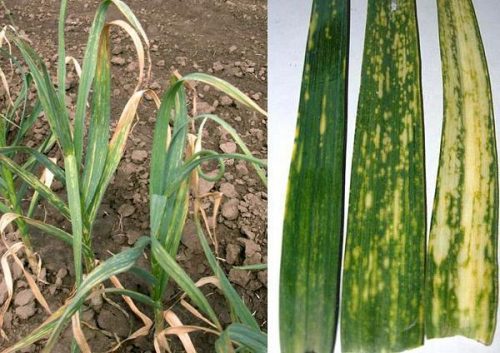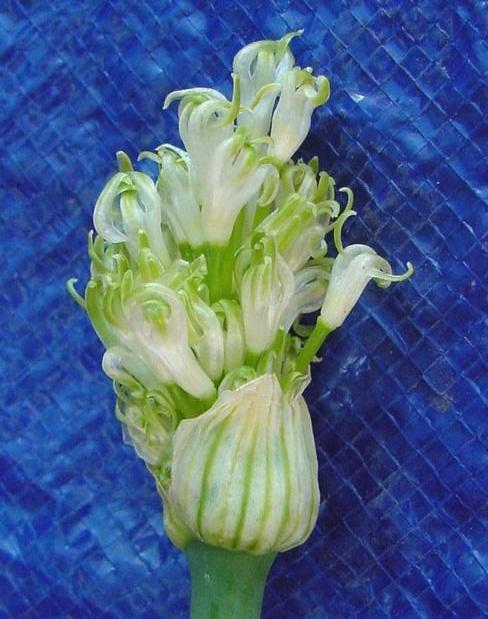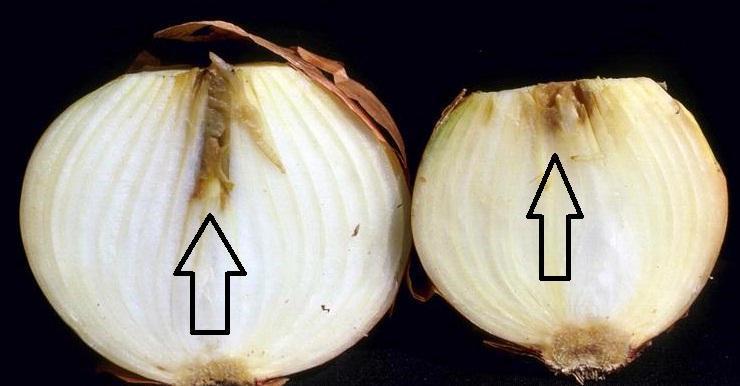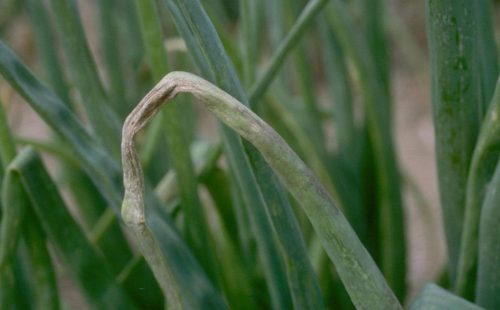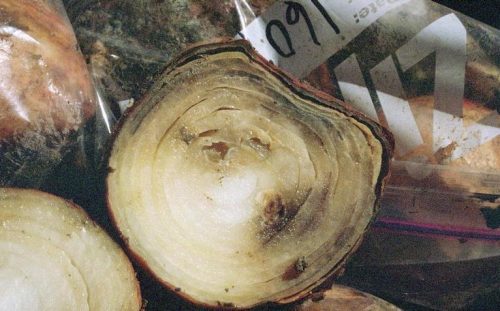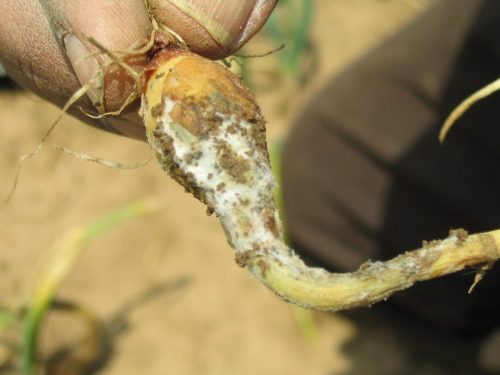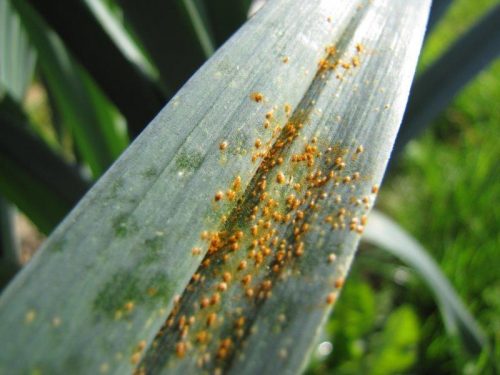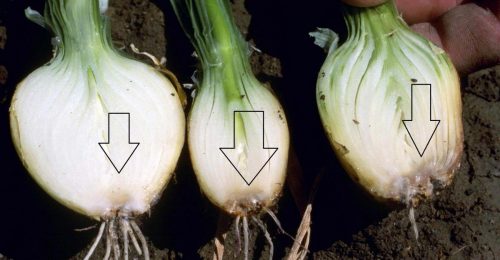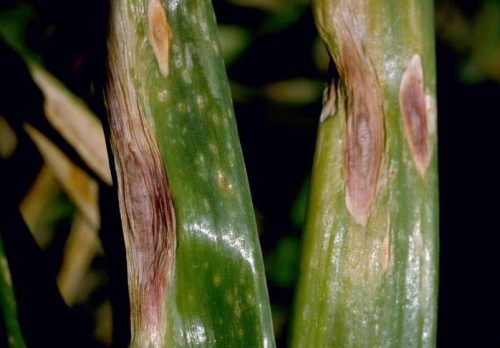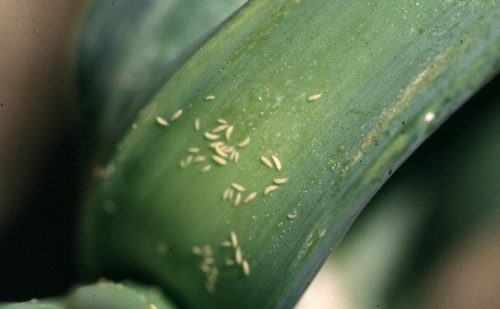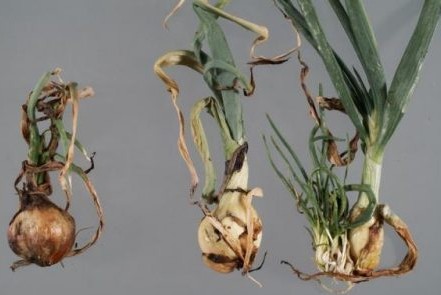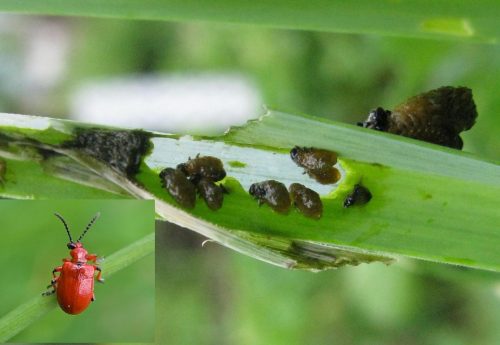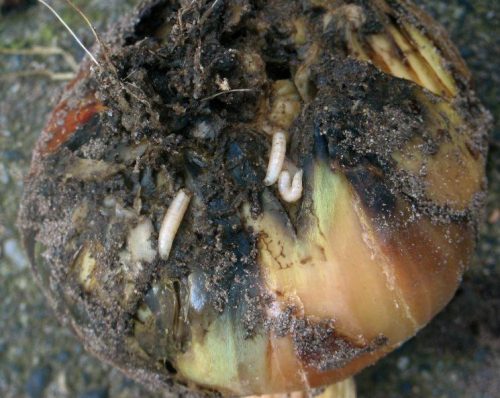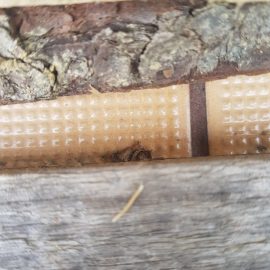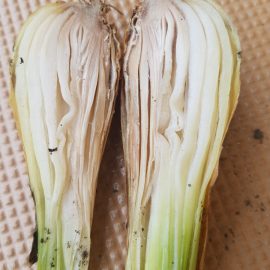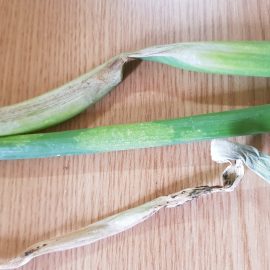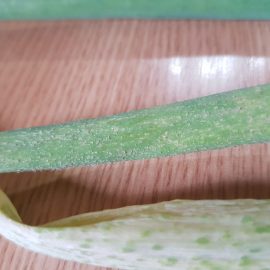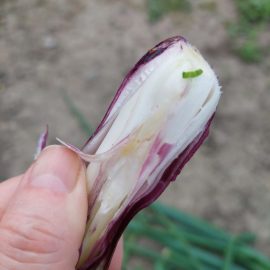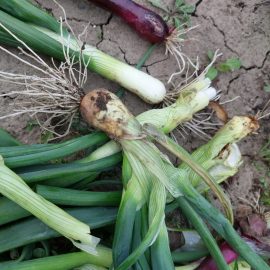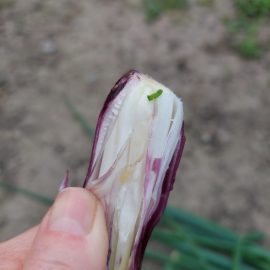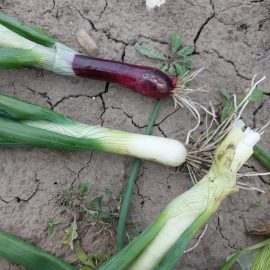Onion, treatments against pests and diseases
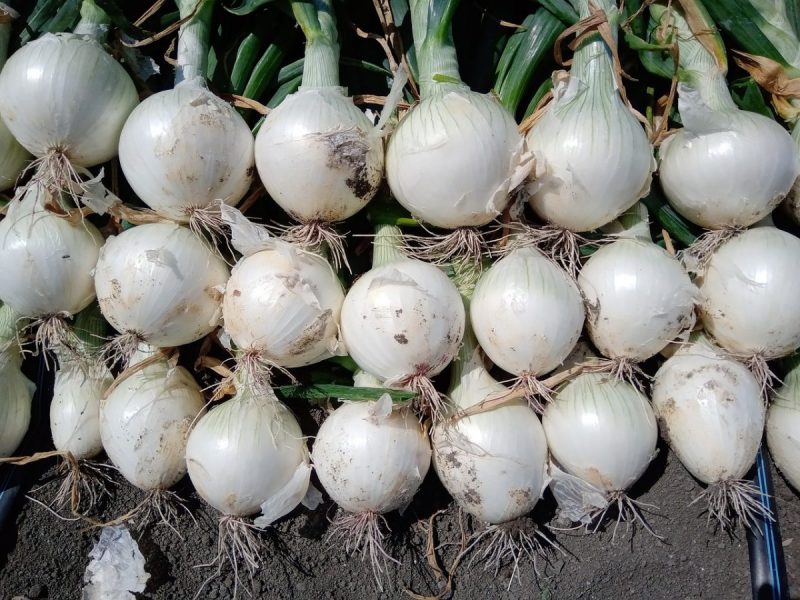
Onion (Allium cepa) comes from the steppe regions of Central and Western Asia. It is one of the oldest cultivated plants, being cultivated for over 5,000 years as a medicinal, spicy, or vegetable plant. The onion can be affected by pests and diseases, against which it’s important to apply the right treatments.
The main diseases of onion
Viruses
Onion yellow dwarf virus
The disease appears on the basal leaves, in the form of yellow stripes. After these symptoms, all developing leaves show symptoms ranging from yellow stripes to complete leaves yellowing. The attacked leaves lie on the ground, and the onions remain small and do not withstand storage during the winter. The virus is transmitted from one plant to another by aphids and the transmission from one year to another is done through infected bulbs. However, the virus is not transmitted through infected seeds. The pathogen attacks all plants in the Aliaceae family (onions, garlic, leeks).
Prevention and control measures:
- the planting material must be healthy;
- applying insecticides to keep the aphid population under control;
- removing affected plants from the crop.
MYCOPLASMOSIS
Phytoplasma disease
The young leaves of diseased plants turn yellow at the bottom, then curl up. Most affected are seed crops because instead of flowers, leaf-like vegetative growths appear. The disease is transmitted by leafhoppers and dodders.
Prevention and control measures:
- removing diseased plants from the crop;
- applying insecticides to keep the leafhopper population under control.
Recommended products
-
You can find products on a different store
Change Store -
You can find products on a different store
Change Store -
You can find products on a different store
Change Store -
You can find products on a different store
Change Store -
You can find products on a different store
Change Store -
You can find products on a different store
Change Store -
You can find products on a different store
Change Store -
You can find products on a different store
Change Store -
You can find products on a different store
Change Store -
You can find products on a different store
Change Store -
You can find products on a different store
Change Store -
You can find products on a different store
Change Store -
You can find products on a different store
Change Store -
You can find products on a different store
Change Store -
You can find products on a different store
Change Store -
You can find products on a different store
Change Store -
You can find products on a different store
Change Store -
You can find products on a different store
Change Store -
You can find products on a different store
Change Store -
You can find products on a different store
Change Store -
You can find products on a different store
Change Store -
You can find products on a different store
Change Store -
You can find products on a different store
Change Store -
You can find products on a different store
Change Store
BACTERIOSIS
Bacterial soft rot (Erwinia carotovora pv. carotovora)
In attacked plants, the stems develop poorly, and at their base, a wet rot appears, which extends throughout the bulb. For bulbs intended for storage, the bacterial attack is manifested by the appearance of a yellow, brown, or grey wet rot on the upper side. As it develops, the bulb changes color, emits an unpleasant smell and by squeezing it out, it releases a foul-smelling liquid. The disease resists on plant debris and is spread by several vectors (water, wind, tools).
Prevention and control measures:
- avoiding sprinkler irrigation;
- treatments immediately after the disease appears with specific fungicides.
Mycosis
Onion downy mildew (Peronospora destructor)
The disease attacks the bulbs, flower stalks, and leaves. The first symptoms appear on the leaves, in the form of elongated spots, light green to yellow, on which a gray-purple fuzz is formed. The attacked tissues soften, the leaf dries, lies on the ground, and rots. Optimum conditions for downy mildew are high humidity for at least 10 hours and temperatures above 12-18ºC.
Prevention and control measures:
- cultural hygiene;
- balanced fertilization;
- correct rotation (onions can be grown on the same land after at least 3 years);
- specific fungicide treatments;
Recommended products
-
You can find products on a different store
Change Store -
You can find products on a different store
Change Store -
You can find products on a different store
Change Store -
You can find products on a different store
Change Store -
You can find products on a different store
Change Store -
You can find products on a different store
Change Store -
You can find products on a different store
Change Store -
You can find products on a different store
Change Store -
You can find products on a different store
Change Store -
You can find products on a different store
Change Store -
You can find products on a different store
Change Store -
You can find products on a different store
Change Store -
You can find products on a different store
Change Store -
You can find products on a different store
Change Store -
You can find products on a different store
Change Store -
You can find products on a different store
Change Store -
You can find products on a different store
Change Store -
You can find products on a different store
Change Store -
You can find products on a different store
Change Store -
You can find products on a different store
Change Store -
You can find products on a different store
Change Store -
You can find products on a different store
Change Store -
You can find products on a different store
Change Store -
You can find products on a different store
Change Store
Botrytis neck and bulb rot (Botrytis allii)
The attack is manifested on the leaves and bulbs, by the appearance of whitish spots, near which the tissue dries. In humid conditions, a gray fuzz appears on the affected areas. Mature plants may show basal rot, followed by bulb rot, and black sclerotia appear on the destroyed areas. Transmission is through soil spores, plant debris spores, or sclerotia.
Prevention and control measures:
- cultural hygiene;
- correct rotation (onions can be planted on the same land after at least 3 years);
- balanced fertilization;
- onion treatments during the growing season with specific fungicides.
Recommended products
-
You can find products on a different store
Change Store -
You can find products on a different store
Change Store -
You can find products on a different store
Change Store -
You can find products on a different store
Change Store -
You can find products on a different store
Change Store -
You can find products on a different store
Change Store -
You can find products on a different store
Change Store -
You can find products on a different store
Change Store -
You can find products on a different store
Change Store -
You can find products on a different store
Change Store -
You can find products on a different store
Change Store -
You can find products on a different store
Change Store -
You can find products on a different store
Change Store -
You can find products on a different store
Change Store -
You can find products on a different store
Change Store -
You can find products on a different store
Change Store -
You can find products on a different store
Change Store -
You can find products on a different store
Change Store -
You can find products on a different store
Change Store -
You can find products on a different store
Change Store -
You can find products on a different store
Change Store -
You can find products on a different store
Change Store -
You can find products on a different store
Change Store -
You can find products on a different store
Change Store
Onion white rot (Stromatinia cepivora)
In wet springs the disease manifests itself in the form of yellowed tips, discoloration that extends to the basal part of them and leads to plant defoliation. The plants have rotten roots and tunics, covered with a fluffy white mycelium, in which the fungus sclerotia are formed. The fungus also resists in warehouses, where it favors the appearance of bacteriosis. The pathogen resists in the soil as sclerotia for 4-5 years.
Prevention and control measures:
- balanced fertilization;
- growing healthy bulbs;
- gathering and destroying plant debris after harvest;
- removing diseased plants from crops;
- onion treatments with specific fungicides.
Recommended products
-
You can find products on a different store
Change Store -
You can find products on a different store
Change Store -
You can find products on a different store
Change Store -
You can find products on a different store
Change Store -
You can find products on a different store
Change Store -
You can find products on a different store
Change Store -
You can find products on a different store
Change Store -
You can find products on a different store
Change Store -
You can find products on a different store
Change Store -
You can find products on a different store
Change Store -
You can find products on a different store
Change Store -
You can find products on a different store
Change Store -
You can find products on a different store
Change Store -
You can find products on a different store
Change Store -
You can find products on a different store
Change Store -
You can find products on a different store
Change Store -
You can find products on a different store
Change Store -
You can find products on a different store
Change Store -
You can find products on a different store
Change Store -
You can find products on a different store
Change Store -
You can find products on a different store
Change Store -
You can find products on a different store
Change Store -
You can find products on a different store
Change Store -
You can find products on a different store
Change Store
Onion rust (Puccinia allii)
Initial symptoms consist of small, irregularly shaped, light brown or white spots on the leaves. Later, these spots enlarge and develop the typical disease pustules, which are dark orange. Severe attack leads to leaf drying and plant wilting.
Prevention and control measures:
- removing diseased plants from crops;
- proper crop rotation (onions can be grown on the same land after at least 3 years);
- growing resistant varieties;
- balanced fertilization;
- gathering and destroying plant debris left over from harvesting;
- chemical onion treatments with specific fungicides.
Recommended products
-
You can find products on a different store
Change Store -
You can find products on a different store
Change Store -
You can find products on a different store
Change Store -
You can find products on a different store
Change Store -
You can find products on a different store
Change Store -
You can find products on a different store
Change Store -
You can find products on a different store
Change Store -
You can find products on a different store
Change Store -
You can find products on a different store
Change Store -
You can find products on a different store
Change Store -
You can find products on a different store
Change Store -
You can find products on a different store
Change Store -
You can find products on a different store
Change Store -
You can find products on a different store
Change Store -
You can find products on a different store
Change Store -
You can find products on a different store
Change Store -
You can find products on a different store
Change Store -
You can find products on a different store
Change Store -
You can find products on a different store
Change Store -
You can find products on a different store
Change Store -
You can find products on a different store
Change Store -
You can find products on a different store
Change Store -
You can find products on a different store
Change Store -
You can find products on a different store
Change Store
Fusarium basal rot in onion (Fusarium oxysporum var. cepae)
The disease sets in on roots, bulbs, or leaves that have been injured during maintenance work or on leaves that have been attacked by pests. Leaves show a slight yellowing on the upper side. The affected bulbs are rotten on the lower side. Affected roots have white spots, which later turn black and the entire root system is destroyed.
Prevention and control measures:
- growing onions on aerated soils;
- growing resistant varieties;
- using healthy planting material;
- onion treatments with specific fungicides.
Recommended products
-
You can find products on a different store
Change Store -
You can find products on a different store
Change Store -
You can find products on a different store
Change Store -
You can find products on a different store
Change Store -
You can find products on a different store
Change Store -
You can find products on a different store
Change Store -
You can find products on a different store
Change Store -
You can find products on a different store
Change Store -
You can find products on a different store
Change Store -
You can find products on a different store
Change Store -
You can find products on a different store
Change Store -
You can find products on a different store
Change Store -
You can find products on a different store
Change Store -
You can find products on a different store
Change Store -
You can find products on a different store
Change Store -
You can find products on a different store
Change Store -
You can find products on a different store
Change Store -
You can find products on a different store
Change Store -
You can find products on a different store
Change Store -
You can find products on a different store
Change Store -
You can find products on a different store
Change Store -
You can find products on a different store
Change Store -
You can find products on a different store
Change Store -
You can find products on a different store
Change Store
Onion purple blotch (Alternaria porri)
The disease manifests itself in all plant organs. Small, whitish spots surrounded by a yellow ring appear on the affected areas. If the disease progresses, the area inside the spots turns brown. In case of severe attack, the fungus also attacks the bulbs. The disease can also continue its activity in the warehouse if the spaces are poorly ventilated and humidity and temperatures are high. The fungus spreads by spores carried by water and wind droplets. In winter, it lives on plant debris on the soil surface.
Prevention and control measures:
- gathering and destroying plant debris from the soil surface;
- correct crop rotation (onions can return to the same field after at least 4 years);
- growing resistant varieties;
- onion treatments with specific fungicides.
Recommended products
-
You can find products on a different store
Change Store -
You can find products on a different store
Change Store -
You can find products on a different store
Change Store -
You can find products on a different store
Change Store -
You can find products on a different store
Change Store -
You can find products on a different store
Change Store -
You can find products on a different store
Change Store -
You can find products on a different store
Change Store -
You can find products on a different store
Change Store -
You can find products on a different store
Change Store -
You can find products on a different store
Change Store -
You can find products on a different store
Change Store -
You can find products on a different store
Change Store -
You can find products on a different store
Change Store -
You can find products on a different store
Change Store -
You can find products on a different store
Change Store -
You can find products on a different store
Change Store -
You can find products on a different store
Change Store -
You can find products on a different store
Change Store -
You can find products on a different store
Change Store -
You can find products on a different store
Change Store -
You can find products on a different store
Change Store -
You can find products on a different store
Change Store -
You can find products on a different store
Change Store
The main pests of onion
Onion thrips
Larvae and adults position in the spaces between the onion leaves, where they sting and suck sap from the plant, causing significant damage to young plants.
Prevention and control measures:
- specific insecticide treatments.
Recommended products
-
You can find products on a different store
Change Store -
You can find products on a different store
Change Store -
You can find products on a different store
Change Store -
You can find products on a different store
Change Store -
You can find products on a different store
Change Store -
You can find products on a different store
Change Store -
You can find products on a different store
Change Store -
You can find products on a different store
Change Store -
You can find products on a different store
Change Store -
You can find products on a different store
Change Store -
You can find products on a different store
Change Store -
You can find products on a different store
Change Store -
You can find products on a different store
Change Store -
You can find products on a different store
Change Store -
You can find products on a different store
Change Store -
You can find products on a different store
Change Store -
You can find products on a different store
Change Store -
You can find products on a different store
Change Store -
You can find products on a different store
Change Store -
You can find products on a different store
Change Store -
You can find products on a different store
Change Store -
You can find products on a different store
Change Store -
You can find products on a different store
Change Store -
You can find products on a different store
Change Store
Stem nematode (Ditylenchus dipsaci)
This nematode overwinters in all stages of development, in the stems or bulbs of various cultivated and wild plants. Nematodes found in soil or infected seeds attack plant roots in spring. As a result of the attack, plants remain small and deform. Attacked bulbs show cracks in the disc area.
Prevention and control measures:
- correct crop rotation (in case of attack, onions can return to the same field after at least 4 years);
- removing attacked plants from the plot;
- growing resistant varieties;
- soil disinfection with specific products.
Recommended products
-
You can find products on a different store
Change Store -
You can find products on a different store
Change Store -
You can find products on a different store
Change Store -
You can find products on a different store
Change Store -
You can find products on a different store
Change Store -
You can find products on a different store
Change Store -
You can find products on a different store
Change Store -
You can find products on a different store
Change Store -
You can find products on a different store
Change Store -
You can find products on a different store
Change Store -
You can find products on a different store
Change Store -
You can find products on a different store
Change Store -
You can find products on a different store
Change Store -
You can find products on a different store
Change Store -
You can find products on a different store
Change Store -
You can find products on a different store
Change Store -
You can find products on a different store
Change Store -
You can find products on a different store
Change Store -
You can find products on a different store
Change Store -
You can find products on a different store
Change Store -
You can find products on a different store
Change Store -
You can find products on a different store
Change Store -
You can find products on a different store
Change Store -
You can find products on a different store
Change Store
Onion beetle (Lilioceris merdigera)
It has two generations per year and overwinters as an adult in the ground. In spring, the adults lay their eggs on onion and garlic leaves along the veins. Larvae and adults feed on the leaves and plant inflorescences, which stagnate in growth and lead to low yields.
Prevention and control measures:
- cultural hygiene and plant debris incorporation into the soil after harvesting.
Onion fly (Delia antique)
It has two to three generations per year and overwinters as a pupa in the topsoil. The adults emerge in spring and lay their tips underground near the onion plants. The larvae burrow into the plant tissue, where they dig feeding galleries. In case of a strong attack, it can destroy the attacked plants.
Prevention and control measures:
- gathering plant debris after harvest;
- carrying out correct autumn ploughing;
- treatments during the growing season with specific insecticides.














































































































































































































































































































































































































































